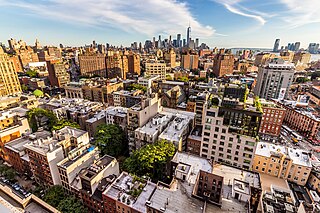
Greenwich Village, or simply the Village, is a neighborhood on the west side of Lower Manhattan in New York City, bounded by 14th Street to the north, Broadway to the east, Houston Street to the south, and the Hudson River to the west. Greenwich Village also contains several subsections, including the West Village west of Seventh Avenue and the Meatpacking District in the northwest corner of Greenwich Village.

Sixth Avenue, also known as Avenue of the Americas, is a major thoroughfare in the New York City borough of Manhattan. The avenue is commercial for much of its length, and traffic runs northbound, or uptown.

8th Street is a street in the New York City borough of Manhattan that runs from Sixth Avenue to Third Avenue and also from Avenue B to Avenue D; its addresses switch from West to East as it crosses Fifth Avenue. Between Third Avenue and Avenue A it is named St. Mark's Place, after the nearby St. Mark's Church in-the-Bowery on 10th Street at Second Avenue.
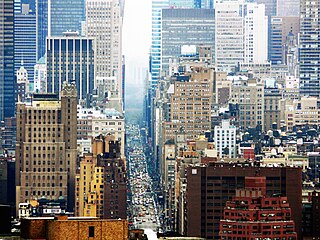
Seventh Avenue—co-named Fashion Avenue in the Garment District and known as Adam Clayton Powell Jr. Boulevard north of Central Park—is a thoroughfare on the West Side of the borough of Manhattan in New York City. It is southbound below the park and a two-way street north of it.

Cafe Wha? is a music club at the corner of MacDougal Street and Minetta Lane in the Greenwich Village neighborhood of Manhattan, New York City. The club is important in the history of rock and folk music, having presented numerous musicians and comedians early on in their careers, including Bob Dylan, Jimi Hendrix, Bruce Springsteen, the Velvet Underground, Cat Mother & the All Night Newsboys, Kool & the Gang, Peter, Paul and Mary, Woody Allen, Lenny Bruce, Joan Rivers, Bill Cosby, and Richard Pryor.

The Gaslight Cafe was a coffeehouse in the Greenwich Village neighborhood of Manhattan, New York. Also called The Village Gaslight, it opened in 1958 and became a venue for folk music and other musical acts. It closed in 1971.
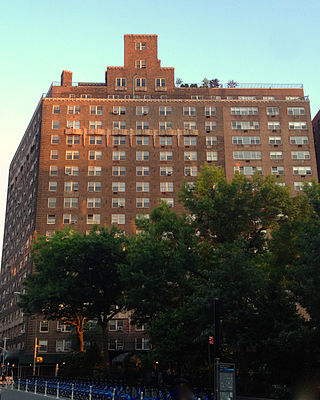
The West Village is a neighborhood in the western section of the larger Greenwich Village neighborhood of Lower Manhattan, New York City. The West Village is bounded by the Hudson River to the west and 14th Street to the north. The eastern boundary is variously cited as Greenwich Avenue, Seventh Avenue, or Sixth Avenue, while the southern boundary is either Houston Street or Christopher Street.

The West Fourth Street–Washington Square station is an express station and transfer stop on the IND Sixth Avenue and IND Eighth Avenue Lines of the New York City Subway, located at the intersection of West Fourth Street and Sixth Avenue in Greenwich Village, Manhattan. It is served by the A, D, E, and F trains at all times; the B and M trains on weekdays; the C train at all times except late nights; and the <F> train during rush hours in the peak direction.
The Seventh Avenue Line is a surface public transit line in Manhattan, New York City, United States, connecting Lower Manhattan with Central Park along Seventh Avenue. Once a streetcar line, it is now part of the southbound direction of the M10 and M20 bus routes.

West Broadway is a north-south street in the New York City borough of Manhattan, separated into two parts by Tribeca Park. The northern part begins at Tribeca Park, near the intersection of Avenue of the Americas, Walker Street and Beach Street in Tribeca. It runs northbound as a one-way street past Canal Street and becomes two-way at the intersection with Grand Street one block farther north. West Broadway then operates as a main north-south thoroughfare through SoHo until its northern end at Houston Street, on the border between SoHo and Greenwich Village. North of Houston Street, it is designated as LaGuardia Place, which continues until Washington Square South.

The Whitney Museum of American Art's original building is a collection of three 1838 rowhouses at 8–12 West 8th Street, between Fifth Avenue and MacDougal Street, in the Greenwich Village neighborhood of Manhattan in New York City. In 1907, Gertrude Vanderbilt Whitney established the Whitney Studio Gallery at 8 West 8th Street adjacent to her own MacDougal Alley studio. This, and the later Whitney Studio Club at 147 West 4th Street, were intended to provide young artists with places to meet and exhibit their works.

MacDougal Street is a one-way street in the Greenwich Village and SoHo neighborhoods of Manhattan, New York City. The street is bounded on the south by Prince Street and on the north by West 8th Street; its numbering begins in the south. Between Waverly Place and West 3rd Street it carries the name Washington Square West and the numbering scheme changes, running north to south, beginning with #29 Washington Square West at Waverly Place and ending at #37 at West 3rd Street. Traffic on the street runs southbound (downtown).

Greenwich Avenue, formerly Greenwich Lane, is a southeast-northwest avenue located in the Greenwich Village neighborhood of Manhattan, New York City. It extends from the intersection of 6th Avenue and 8th Street at its southeast end to its northwestern end at 8th Avenue between 14th Street and 13th Street. It is sometimes confused with Greenwich Street. Construction of West Village Park, bounded by Greenwich Avenue, 7th Avenue, and 12th Street, began in 2016.

The South Village is a largely residential area that is part of the larger Greenwich Village in Lower Manhattan, New York City, directly below Washington Square Park. Known for its immigrant heritage and bohemian history, the architecture of the South Village is primarily tenement-style apartment buildings, indicative of the area's history as an enclave for Italian-American immigrants and working-class residents of New York.

The Charlton–King–Vandam Historic District is a small historic district in Lower Manhattan, New York City. Designated by the New York City Landmarks Preservation Commission (NYCLPC) in 1966, the district contains "the city's largest concentration of row houses in the Federal style, as well as a significant concentration of Greek Revival houses." It is sometimes included as part of the South Village or Hudson Square, though it is historically distinct from both neighborhoods.
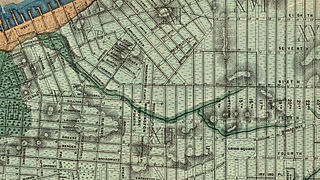
Minetta Creek was one of the largest natural watercourses in Manhattan, New York City, United States. Minetta Creek was fed from two tributaries, one originating at Fifth Avenue and 21st Street, and the other originating at Sixth Avenue and 16th Street. They joined near Fifth Avenue and 11th Street then took a southwesterly course. Minetta Creek's name is thought to have originated from either the Native American term "Manette", meaning "Devil's Water", or the Dutch word "Minnetje", meaning "the little one".
Thompson Street is a street in the Lower Manhattan neighborhoods of Greenwich Village and SoHo in New York City, which runs north–south, from Washington Square Park at Washington Square South to the Avenue of the Americas below Grand Street, where the street turns right to Sixth Avenue; it thus does not connect with Canal Street just a half block south of the turning point. It runs parallel to and between Sullivan Street, and LaGuardia Place which becomes West Broadway. Vehicular traffic goes southbound.

Sullivan Street is a street in Lower Manhattan, which previously ran north from Duarte Square at Canal Street, but since around 2012 begins at Broome Street, to Washington Square South, through the neighborhoods of Hudson Square, SoHo, the South Village and Greenwich Village. It runs parallel to and between Macdougal Street and Thompson Street. Part of the street is in the MacDougal–Sullivan Gardens Historic District. The street was named for Revolutionary War Major General John Sullivan in 1799; before then, it was known as Locust Street.
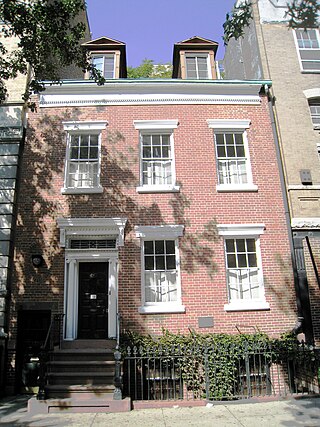
Charles Street is a street in the West Village neighborhood of Manhattan in New York City. It runs east to west from Greenwich Avenue to West Street. The street was named after Charles Christopher Amos, who owned the parcel the street passed through. Amos is also the namesake of Christopher Street, two blocks to the south, and the former Amos Street, which is now West 10th Street. Charles Lane is a one-block alley located between Charles and Perry Streets and Washington and West Streets. From 1866 to 1936, the section of Charles Street between Bleecker Street and West 4th Street was called Van Ness Place after a farm, owned by the Van Ness family, which had occupied the square bounded by Bleecker, West 4th, Charles and Perry Streets until 1865.


















